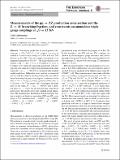Measurements of the pp→ZZ production cross section and the Z→4ℓ branching fraction, and constraints on anomalous triple gauge couplings at √s =13 TeV
Author(s)
Abercrombie, Daniel Robert; Allen, Brandon Leigh; Azzolini, Virginia; Barbieri, Richard Alexander; Baty, Austin Alan; Bi, Ran; Brandt, Stephanie Akemi; Busza, Wit; Cali, Ivan Amos; D'Alfonso, Mariarosaria; Demiragli, Zeynep; Gomez-Ceballos, Guillelmo; Goncharov, Maxim; Hsu, Dylan George; Iiyama, Yutaro; Innocenti, Gian Michele; Klute, Markus; Kovalskyi, Dmytro; Lai, Yue Shi; Lee, Yen-Jie; Levin, Andrew Michael; Luckey Jr, P David; Maier, Benedikt; Marini, Andrea Carlo; McGinn, Christopher Francis; Mironov, Camelia Maria; Narayanan, Siddharth Madhavan; Niu, Xinmei; Paus, Christoph M. E.; Roland, Christof E; Roland, Gunther M; Salfeld-Nebgen, Jakob Maxillian Henry; Stephans, George S. F.; Tatar, Kaya; Velicanu, Dragos Alexandru; Wang, J.; Wang, Ta-Wei; Wyslouch, Boleslaw; ... Show more Show less
Downloads10052-018-5567-9.pdf (2.112Mb)
PUBLISHER_CC
Publisher with Creative Commons License
Creative Commons Attribution
Terms of use
Metadata
Show full item recordAbstract
Four-lepton production in proton-proton collisions, pp → (Z/γ[superscript ∗]) (Z/γ[superscript ∗]) → 4ℓ, where ℓ= e or μ, is studied at a center-of-mass energy of 13 TeV with the CMS detector at the LHC. The data sample corresponds to an integrated luminosity of 35.9fb[superscript -1]. The ZZ production cross section, σ(pp→ZZ)=17.2±0.5(stat)±0.7(syst)±0.4(theo)±0.4(lumi) pb, measured using events with two opposite-sign, same-flavor lepton pairs produced in the mass region 60 < m[subscript ℓ+ℓ-] < 120GeV, is consistent with standard model predictions. Differential cross sections are measured and are well described by the theoretical predictions. The Z boson branching fraction to four leptons is measured to be B(Z → 4ℓ) =4.83[superscript +0.23][subscript -0.22](stat)[superscript +0.32][subscript -0.29](syst)±0.08(theo)±0.12(lumi)×10[superscript -6] for events with a four-lepton invariant mass in the range 80 < m[subscript 4ℓ] < 100GeV and a dilepton mass m[subscript ℓℓ]> 4 GeV for all opposite-sign, same-flavor lepton pairs. The results agree with standard model predictions. The invariant mass distribution of the four-lepton system is used to set limits on anomalous ZZZ and ZZγ couplings at 95% confidence level: -0.0012 < f[superscript Z][subscript 4] < 0.0010, -0.0010 < f[superscript Z][subscript 5] < 0.0013, -0.0012 < f[superscript γ][subscript 4] < 0.0013, -0.0012 < f[superscript γ][subscript 5] < 0.0013.
Date issued
2018-02Department
Massachusetts Institute of Technology. Department of Physics; Massachusetts Institute of Technology. Laboratory for Nuclear ScienceJournal
The European Physical Journal C
Publisher
Springer Berlin Heidelberg
Citation
CMS Collaboration, et al. “Measurements of the pp→ZZ Production Cross Section and the Z→4ℓ Branching Fraction, and Constraints on Anomalous Triple Gauge Couplings at √s = 13TeV.” The European Physical Journal C, vol. 78, no. 2, Feb. 2018. © 2018, CERN for the benefit of the CMS collaboration
ISSN
1434-6044
1434-6052